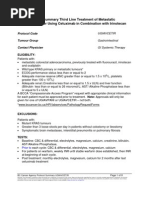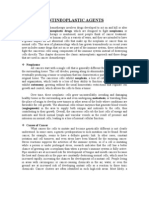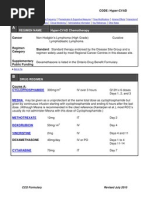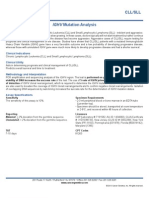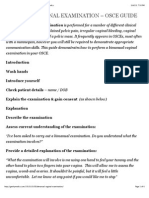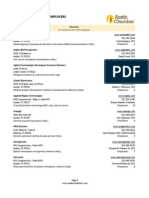BRS62
BRS62
Uploaded by
JaneCopyright:
Available Formats
BRS62
BRS62
Uploaded by
JaneCopyright
Available Formats
Share this document
Did you find this document useful?
Is this content inappropriate?
Copyright:
Available Formats
BRS62
BRS62
Uploaded by
JaneCopyright:
Available Formats
Printed by Isobel Webster on 10/19/2021 7:49:19 PM. For personal use only. Not approved for distribution.
Copyright © 2021 National Comprehensive Cancer Network, Inc., All Rights Reserved.
Chemotherapy Order Template BRS62
Page 1 of 1
Breast Cancer
TC (DOCEtaxel/Cyclophosphamide)
INDICATION: REFERENCES: NCCN SUPPORTIVE CARE:
HER2 negative: Neoadjuvant or Adjuvant 1. NCCN Guidelines® for Breast Cancer 1. Emetic risk: Day 1 Moderate
V.2.2021. 2. Febrile Neutropenia Risk: Refer to Myeloid
2. Jones SE, et al. J Clin Oncol. Growth Factor algorithms in the NCCN
2009;27(8):1177-83.a Guidelines for Hematopoietic Growth Factors
CHEMOTHERAPY REGIMEN
21-day cycle for 4 cycles
DOCEtaxel 75 mg/m² IV over 60 minutes on Day 1
Cyclophosphamide 600 mg/m² IV over 30 minutes on Day 1
Oral hydration is strongly encouraged with cyclophosphamide; poorly hydrated patients may need supplemental IV hydration. Patients
should attain combined oral and IV hydration of 2,000 – 3,000 mL/day on day of chemotherapy.
See Other Supportive Therapy for example of IV hydration.
SUPPORTIVE CARE
Premedications
For DOCEtaxel: Premedication with dexamethasone for fluid retention is required. One recommended dosing strategy is:
Dexamethasone 8 mg PO BID for three consecutive days starting 1 day prior to DOCEtaxel administration
Antiemetic Therapy
Scheduled prophylactic antiemetic therapy should be given for prevention of acute and delayed nausea and vomiting based on the emetic risk of
the chemotherapy regimen. This may include antiemetic therapy given on the days following chemotherapy. For more information on emetic
prophylaxis, refer to the NCCN Guidelines for Antiemesis and Appendix D to the NCCN Chemotherapy Order Templates.
PRN for breakthrough: All patients should be provided with at least one medication for breakthrough emesis. Please consult the NCCN
Guidelines for Antiemesis for appropriate antiemetic therapy.
No additional dexamethasone needed for antiemesis on the day(s) dexamethasone already given for fluid retention.
Other Supportive Therapy
For cyclophosphamide: Example of recommended hydration: Sodium chloride 0.9% infused IV at a rate of 1.5 – 3 mL/kg/hour for a total of
500 mL on day of chemotherapy.
MONITORING AND HOLD PARAMETERS
CBC with differential should be monitored as clinically indicated for potential dose modification.
For DOCEtaxel:
Hypersensitivity reaction may occur with administration. Monitor for and treat hypersensitivity reactions (e.g. anaphylaxis, hives, throat
tightness and/or hypotension) per institutional standard. Initiation and/or adjustment of premedications should be considered. Infusion
rate changes or discontinuation of treatment may be warranted. Refer to the "Management of Drug Reactions" algorithm in the NCCN
Guidelines for Ovarian Cancer for additional information and recommendations.
This agent may cause peripheral neuropathy. Monitor patients as clinically indicated for persistent issues with altered sensation
including pain or discomfort and/or regional motor weakness that may interfere with activities of daily living. Dose modification or
discontinuation of therapy may be warranted.
Liver function should be monitored prior to each cycle for potential dose modification or discontinuation.
Fluid retention may occur. Patient should be monitored as clinically indicated for signs and symptoms.
This agent may cause changes to fingernails and toenails including onycholysis, along with color, texture, and shape changes. This is
usually a reversible side effect, but should be monitored throughout treatment.
For cyclophosphamide: Renal function should be monitored as clinically indicated for potential dose modification or discontinuation.
SAFETY PARAMETERS AND SPECIAL INSTRUCTIONS
For DOCEtaxel:
This agent is an irritant.
This agent should be administered through non-PVC tubing.
For cyclophosphamide: Secondary malignancies have been associated with this drug. Review drug package insert for additional information.
NCCN Chemotherapy Order Templates (NCCN Templates®) are peer-reviewed statements of the consensus of its authors derived from the NCCN Clinical Practice Guidelines in Oncology (NCCN Guidelines®)
regarding their views of currently accepted approaches to treatment. An NCCN Template does not constitute an order. Any clinician seeking to treat a patient using the NCCN Templates® is expected to use
independent medical judgment in the context of individual clinical circumstances of a specific patient's care or treatment. NCCN disclaims all warranties, express or implied including, without limitation, the
implied warranties of merchantability and fitness for a particular purpose. NCCN does not warrant the accuracy, currency, or completeness of the NCCN Templates or make any representation regarding the
use or the results of the use of the NCCN Templates in treatment. In no event shall NCCN or its members be liable for any damages including, without limitation, incidental, indirect, special, punitive, or
consequential damages arising out of or in connection with the use of the NCCN Templates including, without limitation, loss of life, loss of data, loss of income or profit, losses sustained as a result of any
injury to any person, or loss or damage to property or claims of third parties.
National Comprehensive Cancer Network, Inc. © 2021. All rights reserved. 03/18/2021
You might also like
- Observer by Robert LanzaDocument342 pagesObserver by Robert LanzaGabriela RadianNo ratings yet
- Veterinary Diagnostic Imaging, The Dog and Cat (Vetbooks - Ir) PDFDocument786 pagesVeterinary Diagnostic Imaging, The Dog and Cat (Vetbooks - Ir) PDFLeonardo A. Muñoz Dominguez100% (1)
- Master List Measles Grade 6 TWODocument8 pagesMaster List Measles Grade 6 TWOjoemer mabagosNo ratings yet
- Pancreatic Adenocarcinoma: Albumin-Bound Paclitaxel/GemcitabineDocument1 pagePancreatic Adenocarcinoma: Albumin-Bound Paclitaxel/GemcitabineJaneNo ratings yet
- Template Continued On Page 2: Indication: References: NCCN Supportive CareDocument2 pagesTemplate Continued On Page 2: Indication: References: NCCN Supportive CareJaneNo ratings yet
- Template Continued On Page 2: Dose-Dense Ac (Doxorubicin/Cyclophosphamide) CourseDocument2 pagesTemplate Continued On Page 2: Dose-Dense Ac (Doxorubicin/Cyclophosphamide) CourseJaneNo ratings yet
- Template Continued On Page 2Document3 pagesTemplate Continued On Page 2JaneNo ratings yet
- 385 Cisplatin 40mg m2 Weekly With Radiotherapy RTDocument5 pages385 Cisplatin 40mg m2 Weekly With Radiotherapy RTteste testNo ratings yet
- 311 Topotecan Monotherapy 5 DayDocument4 pages311 Topotecan Monotherapy 5 DayRuxandra BănicăNo ratings yet
- Ulkamlaven ProtocolDocument10 pagesUlkamlaven ProtocolLeutrim S. SalltekuNo ratings yet
- 249 Intrathecal Methotrexate For Cns Prophylaxis in GTNDocument3 pages249 Intrathecal Methotrexate For Cns Prophylaxis in GTNparamitaekadevaNo ratings yet
- Protocol Dexamethasone As Treatment For Cerebral EdemaDocument2 pagesProtocol Dexamethasone As Treatment For Cerebral EdemaAnonymous 1LXEUoQCm8No ratings yet
- Oncology Supportive Care Update BCPS 2021-1Document106 pagesOncology Supportive Care Update BCPS 2021-1Mr.ShazNo ratings yet
- BevacizumabDocument4 pagesBevacizumabMartínez Roldán Johana Yadira 3EZNo ratings yet
- Atezolizumab-FDA LabelDocument38 pagesAtezolizumab-FDA LabelClarissa BCNo ratings yet
- 14: Drugs Used in Malignant Diseases and For ImmunosuppressionDocument36 pages14: Drugs Used in Malignant Diseases and For ImmunosuppressionleonNo ratings yet
- Chemotherapy Protocol: RegimenDocument6 pagesChemotherapy Protocol: RegimenAlexandra AndronescuNo ratings yet
- Fluorouracil Drug StudyDocument8 pagesFluorouracil Drug StudyAlexandrea MayNo ratings yet
- FLUOROURACIL Drug StudyDocument8 pagesFLUOROURACIL Drug StudyAlexandrea MayNo ratings yet
- LYCHOP Protocol 1aug2014Document3 pagesLYCHOP Protocol 1aug2014Nararto PrijogoNo ratings yet
- KS Treatment Plan 4 21 2010 2Document4 pagesKS Treatment Plan 4 21 2010 2Iuliana NitaNo ratings yet
- ULUAVNIV ProtocolDocument10 pagesULUAVNIV ProtocolsatishNo ratings yet
- CetuximabDocument8 pagesCetuximabcrespo2816100% (1)
- Dexamethasone: Quick LinksDocument5 pagesDexamethasone: Quick Linksali aliNo ratings yet
- What Are Current Recommendations For Treatment of Drug ExtravasationDocument13 pagesWhat Are Current Recommendations For Treatment of Drug ExtravasationThắng NguyễnNo ratings yet
- Severe Ulcerative Colitis UHL Childrens Medical GuidelineDocument8 pagesSevere Ulcerative Colitis UHL Childrens Medical GuidelineFanny PritaningrumNo ratings yet
- Doxorubicin: Mechanism of ActionDocument3 pagesDoxorubicin: Mechanism of ActionGeorge FogNo ratings yet
- GUEP ProtocolDocument3 pagesGUEP ProtocolAbhijitDasNo ratings yet
- Drug Study - Feb 16Document9 pagesDrug Study - Feb 16ciela00034No ratings yet
- 23 2014-23-BD Lymphoctopenia 2014Document4 pages23 2014-23-BD Lymphoctopenia 2014Dr. Taha NazirNo ratings yet
- SOGC DVT ProphylaxisDocument16 pagesSOGC DVT Prophylaxisibrahimnazeh96No ratings yet
- Full Prescribing Information Boxed WarningDocument62 pagesFull Prescribing Information Boxed WarningStirNo ratings yet
- Full Prescribing Information Boxed WarningDocument62 pagesFull Prescribing Information Boxed WarningStirNo ratings yet
- Scnausea Protocol 1mar2012Document6 pagesScnausea Protocol 1mar2012Afra FitrianitaNo ratings yet
- BRAJAC Protocol 1feb2014Document2 pagesBRAJAC Protocol 1feb2014Claudia TiffanyNo ratings yet
- Antineoplastic DrugsDocument38 pagesAntineoplastic DrugsTrixia CamporedondoNo ratings yet
- Altretamine: Drug DosageDocument16 pagesAltretamine: Drug DosagePrincess CruzNo ratings yet
- New CDDCDocument44 pagesNew CDDCTilaye GebruNo ratings yet
- OncologyDocument5 pagesOncologyAlamgir Khan YousafxaiNo ratings yet
- 2019 Antiemetic Recommendations For Chemotherapy-Induced Nausea and Vomiting: A Clinical Practice GuidelineDocument31 pages2019 Antiemetic Recommendations For Chemotherapy-Induced Nausea and Vomiting: A Clinical Practice Guidelinehusni gunawanNo ratings yet
- Zejula USPI October 2019Document23 pagesZejula USPI October 2019joeng puddingNo ratings yet
- (RODRIGUEZ) Case 1-HardDocument9 pages(RODRIGUEZ) Case 1-HardDinarkram Rabreca EculNo ratings yet
- Vinblastin Kel 1Document14 pagesVinblastin Kel 1silvyfebryNo ratings yet
- 383 Gemcitabine 1000mg m2 and Cisplatin 25mg m2 Therapy 21 DayDocument5 pages383 Gemcitabine 1000mg m2 and Cisplatin 25mg m2 Therapy 21 Dayyesenia huertaNo ratings yet
- Medicalscience: EcancerDocument7 pagesMedicalscience: Ecancerfiora.ladesvitaNo ratings yet
- 1.13 Hyper-CVAD-MA Version 2.1Document5 pages1.13 Hyper-CVAD-MA Version 2.1Alina CrissNo ratings yet
- 659 Trastuzumab Emtansine Kadcyla Early Breast Cancer Therapy 21 DaysDocument8 pages659 Trastuzumab Emtansine Kadcyla Early Breast Cancer Therapy 21 DaysElena MNo ratings yet
- LYCHOP ProtocolDocument4 pagesLYCHOP ProtocolLola WooNo ratings yet
- MOH Systemic Protocol 2016Document184 pagesMOH Systemic Protocol 2016ywNo ratings yet
- Cancer-And Chemotherapy - Induced Anemia: Clinical Practice Guidelines in OncologyDocument26 pagesCancer-And Chemotherapy - Induced Anemia: Clinical Practice Guidelines in OncologySisisNo ratings yet
- Efek Kemo PDFDocument8 pagesEfek Kemo PDFAgil Rumboko SumitroNo ratings yet
- neupogen_pi_hcp_englishDocument46 pagesneupogen_pi_hcp_englishebm2goNo ratings yet
- HNLADCF ProtocolDocument5 pagesHNLADCF ProtocolCristina Ștefania RădulescuNo ratings yet
- AntiNeoplastic AgentsDocument33 pagesAntiNeoplastic Agentsmers puno100% (1)
- Onconephrology: Update in Anticancer Drug-Related NephrotoxicityDocument13 pagesOnconephrology: Update in Anticancer Drug-Related NephrotoxicityFreddy Shanner Chávez VásquezNo ratings yet
- Drug Name Mechanism of Action Indication Contraindication Side Effects/Adverse Reaction Nursing Responsibility CNS-malaiseDocument3 pagesDrug Name Mechanism of Action Indication Contraindication Side Effects/Adverse Reaction Nursing Responsibility CNS-malaisekristel_nicole18yahoNo ratings yet
- 33 2016-33-IJHS-Monocyto-2016Document6 pages33 2016-33-IJHS-Monocyto-2016Dr. Taha NazirNo ratings yet
- final carboplatin 1Document2 pagesfinal carboplatin 1samisoso939No ratings yet
- Dactinomycin MonographDocument8 pagesDactinomycin MonographWahyu RellyNo ratings yet
- 248 Ema Co Therapy Etoposide Methotrexate Dactinomycin Cyclophosphamide VincristineDocument8 pages248 Ema Co Therapy Etoposide Methotrexate Dactinomycin Cyclophosphamide Vincristinenehajaglan11No ratings yet
- DaptomycinDocument1 pageDaptomycinsalwafathiNo ratings yet
- Hyper Cvad NHLhiDocument6 pagesHyper Cvad NHLhisevag002816No ratings yet
- CheòotherqpieDocument13 pagesCheòotherqpieAyoub LilouNo ratings yet
- IGHV Mutation AnalysisDocument2 pagesIGHV Mutation AnalysisCGIdocsNo ratings yet
- Elated QuotesDocument28 pagesElated Quotesshasha001No ratings yet
- Aetna Student Health Plan Design and Benefits Summary Notre Dame 2018 19-7-24 18Document38 pagesAetna Student Health Plan Design and Benefits Summary Notre Dame 2018 19-7-24 18MESSI SURYA 10No ratings yet
- How To Get Pregnant With PcosDocument20 pagesHow To Get Pregnant With PcosConfused parent0% (1)
- Johnson Jerry Alan Chinese Medical Qigong Therapy Vol 5-261-280Document20 pagesJohnson Jerry Alan Chinese Medical Qigong Therapy Vol 5-261-280toanbauNo ratings yet
- SteroidsDocument3 pagesSteroidsapi-236946512No ratings yet
- The Researchers Came Up To Develop A New Variety of NuggetsDocument4 pagesThe Researchers Came Up To Develop A New Variety of Nuggetsclaudys100% (1)
- Medical Coding Test Q&ADocument24 pagesMedical Coding Test Q&ALeah Lee100% (2)
- Tripod FractureDocument45 pagesTripod Fracturekenn ParrochoNo ratings yet
- Unit 3 Module 9 CombinedDocument14 pagesUnit 3 Module 9 Combinedapi-2930012170% (1)
- DR Shubranshuprofile PDFDocument4 pagesDR Shubranshuprofile PDFBablu JiNo ratings yet
- Bimanual Vaginal Examination - OSCE Guide - Geeky MedicsDocument6 pagesBimanual Vaginal Examination - OSCE Guide - Geeky MedicsJahangir AlamNo ratings yet
- Neoplasia PDFDocument182 pagesNeoplasia PDFmarwaNo ratings yet
- Mid Term 5aDocument3 pagesMid Term 5aJessica Lorena HernándezNo ratings yet
- EpidemiologyDocument86 pagesEpidemiologySainab Moohamoud83% (6)
- First Aid MnemonicsDocument27 pagesFirst Aid MnemonicsRafael G. Garcia SanchezNo ratings yet
- Siemens CT - Low - Dose - GuideDocument66 pagesSiemens CT - Low - Dose - GuideSyazwanee Nasir100% (1)
- 07a. Non Neoplastic Disease of OesophagusDocument35 pages07a. Non Neoplastic Disease of Oesophagus21701101016 - Juliana Ayu NugrahaNo ratings yet
- Whiteford2007 Abses PerianalDocument8 pagesWhiteford2007 Abses PerianalPudyo KriswhardaniNo ratings yet
- Glossary: Unit 2: It's Good For You GROUP 2Document5 pagesGlossary: Unit 2: It's Good For You GROUP 2Phuong HanhNo ratings yet
- Applied Therapeutics II MID PDFDocument10 pagesApplied Therapeutics II MID PDFبراء طاهر حاتمNo ratings yet
- List - Bio Companies by Category W - CEO PDFDocument24 pagesList - Bio Companies by Category W - CEO PDFJerryNo ratings yet
- 2 Edvol 2 P 2 BDocument190 pages2 Edvol 2 P 2 BJin SiclonNo ratings yet
- Art. DanazolDocument9 pagesArt. DanazolmrintraNo ratings yet
- Ielts WorkshopDocument18 pagesIelts WorkshopChristian Beren100% (1)
- DR House Season 4Document235 pagesDR House Season 4ederhrNo ratings yet






















